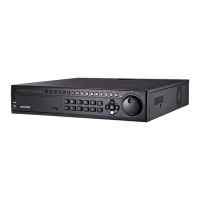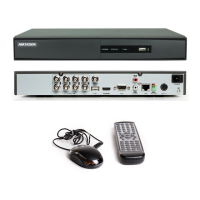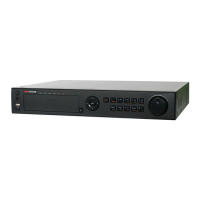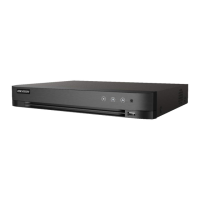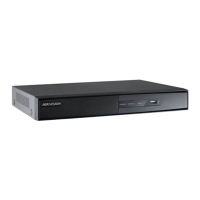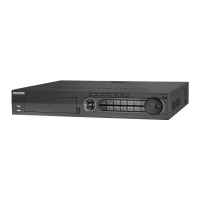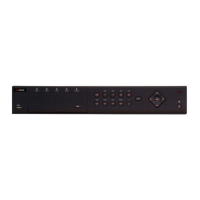
Do you have a question about the HIKVISION DS-7208 and is the answer not in the manual?
Provides a general introduction to the DS-72xx series DVR, highlighting its platform and technologies.
Details the main functionalities and capabilities of the DVR, including compression, monitoring, and HDD management.
Illustrates the DVR's connectivity and typical setup with various components like PCs, cameras, and monitors.
Explains how to use the physical buttons on the DVR's front panel for navigation and operation.
Details the operation of the DVR using the infrared remote control and its key functions.
Describes how to navigate and control the DVR using a standard 3-button USB mouse.
Explains the on-screen keyboard interface for text input when using a mouse with the DVR.
Guides through the proper procedures for powering the DVR on and off to ensure longevity.
Provides instructions for restarting the DVR and locking it for security.
Walks through the initial configuration process for the DVR, covering essential settings.
Steps to configure the system's date and time for accurate event logging and timestamps.
Details how to view real-time video feeds from connected cameras on the DVR.
Explains the meaning of various icons displayed during the live view mode.
Describes methods for navigating and controlling the live preview interface using panel or mouse.
Explains how to access live preview features like single camera, playback, and zoom via mouse.
Details how to magnify specific areas of the live video feed for closer inspection.
Customizing display settings like video output, mode, dwell time, and camera order.
Arranging the sequence of cameras displayed in multi-view modes for logical monitoring.
Prepares the DVR by configuring essential recording parameters like resolution and frame rate.
Setting specific times and days for the DVR to automatically start recording video.
Initiating recording manually for immediate capture of live video.
Prevents accidental deletion of important recorded video files by locking them.
Configures the hard drive to prevent writing, protecting data from being overwritten.
Overview of controls and elements for viewing recorded footage efficiently.
Retrieving and playing recordings based on specific search criteria like time and file type.
Accessing recent recordings directly from the live view mode for quick review.
Playing video associated with specific system log events for context.
Reviewing recordings one frame at a time for detailed analysis and event pinpointing.
Transferring recorded video files to external storage devices like USB drives.
Extracting specific segments or clips of recorded video for backup.
Performing operations like formatting or creating folders on backup media.
Configuring the system to record upon detecting movement in specified areas.
Setting up external alarm devices to trigger recordings or other actions.
Manually activating alarm outputs through the manual alarm menu.
Setting up alerts for when a video signal is lost from a camera.
Configuring alerts for camera tampering or repositioning.
Configuring alerts for various abnormal DVR events like HDD errors or network issues.
Explains how to configure actions for detected exceptions, such as audio warnings or email.
Setting IP address, subnet mask, default gateway, and DNS server information.
Setting up Point-to-Point Protocol over Ethernet for network access.
Setting up Dynamic DNS to provide a consistent domain name for remote access.
Synchronizing DVR time with a Network Time Protocol server for accurate timestamps.
Setting up a remote server to receive alarm signals triggered by the DVR.
Configuring multicast settings for efficient video streaming over the network.
Changing default server and HTTP port numbers for remote client access.
Configuring email settings for receiving alerts and event notifications.
How to access and navigate PTZ control menus using mouse or panel.
Setting up parameters for PTZ camera operation, ensuring proper connection.
Guides on setting camera positions, sequences, and movement paths for PTZ cameras.
Setting specific camera positions for quick recall via presets.
Defining sequences of presets for automated camera movement between key points.
Recording and playing back camera movement paths for automated surveillance.
Setting up on-screen display for camera name, date, and time on video feeds.
Masking sensitive or private areas in the camera's field of view.
Adjusting brightness, contrast, saturation, and hue for camera feeds.
Preparing new hard drives for use by the DVR by formatting them.
Organizing multiple hard drives into logical groups for recording management.
Changing HDD status to redundancy, read-only, or read/write.
Configuring a hard drive to prevent writing, protecting data from overwriting.
Setting up a second drive to mirror data for redundancy against disk failure.
Monitoring the operational status and health of installed hard drives.
Setting up alerts for HDD errors, abnormal states, or initialization failures.
Adjusting system-wide parameters like language, time zone, and date format.
Accessing and modifying more detailed system configurations like device name and timeouts.
Setting up parameters for RS-232 serial communication for connected devices.
Creating new user accounts with specific permission levels for DVR access.
Removing existing user accounts from the DVR.
Editing existing user information and permissions.
Saving and loading DVR settings for backup or efficient deployment on multiple units.
Installing new firmware via USB or network to update or improve DVR functionality.
Definitions of technical terms used throughout the DVR manual.
Frequently asked questions and their corresponding solutions for common issues.
